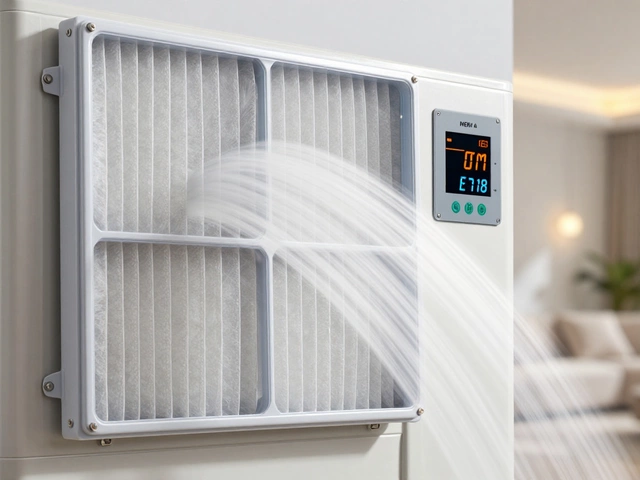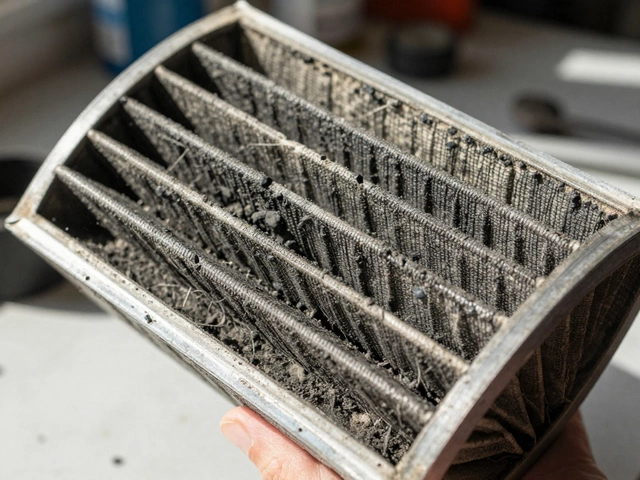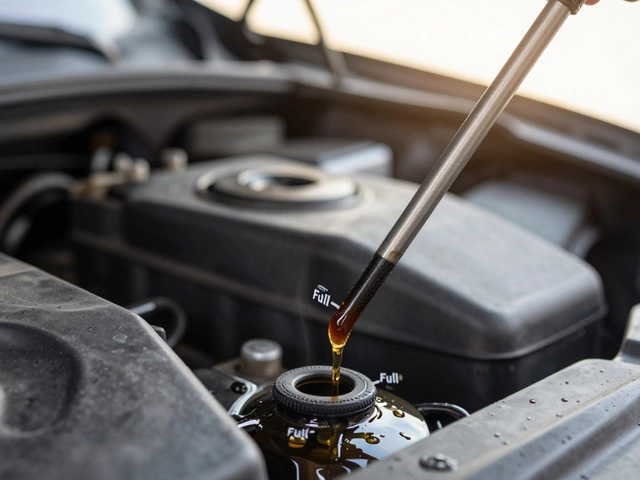
For many drivers, a cracked radiator is an unexpected annoyance that can catch you off guard. Not only does it threaten the smooth operation of your vehicle, but it can also lead to costly repairs if not addressed promptly. Understanding the best ways to handle this problem could spare you a significant headache down the road.
This article aims to guide you through identifying, assessing, and effectively repairing a cracked radiator. Whether you are looking for quick fixes or considering a full replacement, we will explore practical solutions that suit different situations and budgets. Stay informed and equipped to make the best decision for your car's health and longevity.
- Understanding Radiator Issues
- Signs of a Cracked Radiator
- Temporary Fixes for Radiator Cracks
- When to Replace Your Radiator
- Choosing the Right Replacement
- Tips for Radiator Maintenance
Understanding Radiator Issues
The radiator is a crucial component of your car's cooling system. Its primary role is to keep the engine from overheating by circulating coolant through coils, effectively transferring heat away from the engine. A cracked radiator disrupts this process, leading to a cascading effect of problems that can make a vehicle entirely undriveable. Radiators are typically made from aluminum, though older models might feature a mix of aluminum and brass, which makes them highly efficient yet somewhat fragile under extreme conditions.
When we talk about radiators in vehicles, we're addressing a part that is always working under pressure—both literally and figuratively. The constant cycle of heating and cooling, exacerbated by vibrations from the road, can stress its materials, making even tiny fractures expand over time. These minute cracks can manifest as leaks, leading to a drop in the cooling system's efficiency. This inefficiency, if left unchecked, can quickly cause the engine to overheat, resulting in severe mechanical damage.
Cracks often appear at the core's seams or along connections with hoses, where material joins are typically weaker. Sometimes, these issues develop due to old age or corrosion, which can eat away at the radiator's metal over time. In winter, water-based coolants that aren't adequately mixed with antifreeze can freeze, expanding and fracturing the radiator, a costly reminder of climate's impact on car maintenance. Proactive attention to signs of wear and diligent inspection might spot these minor issues before they become expensive repairs.
"A stitch in time saves nine," a wise adage in preventive automotive care, echoed by experts in car maintenance everywhere.
Some radiators are equipped with plastic tanks attached to either side, which are more susceptible to cracking due to repeated thermal cycling. When considering materials, aluminum tends to be more durable against corrosion compared to iron, yet it can be less forgiving under physical stress, making faults like dents or impacts particularly concerning. Routine checks may alert you to impending problems early, safeguarding against bigger issues.
It is worth noting that the issues surrounding a cracked radiator also extend beyond the physical component itself. The environmental side effects, such as coolant leaks, possess the potential for serious ecological harm if not properly contained. Liquid coolants typically contain ethylene glycol or propylene glycol, which are toxic substances requiring careful handling. Hence, it’s crucial to address radiator issues promptly—not just for your vehicle's health, but also for environmental responsibility.
Signs of a Cracked Radiator
Recognizing the signs of a cracked radiator early on can make a significant difference in preventing severe damage to your vehicle. One of the most common indicators is a noticeable puddle of coolant beneath the car after it’s been parked for a while. This typically suggests a leak, although other issues could be responsible, so it’s essential to inspect the radiator carefully. The coolant in a vehicle usually has a distinct color and odor, which can help in early identification of the source of the leak.
Another key symptom to watch out for is an unexpected increase in engine temperature. If the radiator is compromised, it may not effectively maintain the engine's temperature, leading to overheating, a condition you can often monitor through the car’s temperature gauge on the dashboard. Unchecked, this can escalate into severe engine damage, costing hundreds or thousands in repairs. Also, if the radiator is cracked, you might notice steam or vapor escaping from under the hood. This is particularly evident when the car has been idling for a considerable amount of time.
Keep an eye on the performance of your heating system, too. A faulty radiator might result in poor heat distribution within the car’s cabin. So if you’re no longer getting that warm cozy feeling inside even after adjusting the heat dial, your radiator might be crying for attention. On top of that, physical symptoms like rust or discoloration on the radiator itself can hint at unseen damage. Carefully inspecting the radiator’s body for any deformities or irregularities might help uncover the crack.
“Regular maintenance checks are vital for detecting cracks in radiators early,” notes one mechanic expert from an automotive magazine. “Ignoring the signs can lead to an expensive cascade of engine issues that most car owners would prefer to avoid.”
Last but not least, it’s essential to ensure there are no air bubbles in the coolant reservoir. This can often be missed, but if air is getting into the system, it can indicate a crack in the radiator or related components. Tops are not that hard to spot. While it may take a sharp eye to discern these signs at first, familiarity grows with practice and consistent observation. Trouble on the horizon might just present itself as the faintest clue, urging a quick fix before it grows.
Temporary Fixes for Radiator Cracks
When you're out on the road and suddenly notice steam billowing from under the hood or your temperature gauge soaring to unsettling heights, it’s likely a cracked radiator causing this commotion. Before you panic, know that there are temporary fixes that can help you manage the situation long enough to get your vehicle to a professional or back home safe and sound. These quick solutions are not meant to be permanent repairs, but they can provide a much-needed stopgap when you need it most. Understanding what to do in such emergencies can save you from being stranded or facing severe engine damage.
One of the most popular temporary solutions is the use of a radiator sealant. This product is designed to fill small leaks within your cracked radiator, acting much like a band-aid. The sealant is added directly to the radiator or overflow tank while the engine is cool. Once the engine runs, the heat causes the sealant to harden into a durable patch over the leak. Many car enthusiasts have praised this quick fix for its ease of use and surprising effectiveness. However, caution is necessary as not every sealant is compatible with all coolants, so always check the label for compatibility.
Another household fix involves using an epoxy paste. This method is a bit more hands-on and requires you to drain the radiator completely, remove it if necessary, and dry the cracked area thoroughly before applying the paste. Once set, the epoxy provides a stable and semi-permanent solution, ideal for small to moderate cracks. It's beneficial to carry this along with a sandpaper kit and gloves in your trunk to perform minor repairs wherever needed. Drivers should also consider products like gasket patches that can quickly adhere over leaks, but these are more suitable for minor damages.
In some instances, using pepper or egg whites has been touted as an age-old trick. Surprisingly, sprinkling a few teaspoons of pepper into the radiator can temporarily clog small leaks. Similarly, when the egg white is added to a cool radiator, it cooks and solidifies when the engine heats up, which can seal a crack. Though not a long-term answer, such creative hacks might allow you to drive a few miles to the nearest service station. These unconventional methods have saved many motorists from costly towing fees over the years.
"Radiators are much like soufflés, sometimes things just don't go according to plan," auto technician Darren Reilly noted with humor, highlighting the fact that no matter how much you prepare, leaks and cracks can happen unexpectedly. "Knowing a few tricks can be the difference between a minor inconvenience and an expensive repair bill."
Important Considerations
It’s important to remember that while these temporary fixes can be lifesavers, they should not substitute for a proper repair or replacement. Operating a vehicle with even a minor coolant leak can lead to engine overheating and damage. If you're only using a temporary solution, make arrangements to visit your trusted mechanic as soon as possible. Check the coolant levels often, listen for unusual engine sounds, and never ignore the temperature warnings on your dashboard.
Avoiding Future Radiator Problems
Taking preventive measures is key when it comes to car maintenance. Regularly check your coolant levels and look out for leaks or rust accumulation. Flush and replace the coolant according to your car's maintenance schedule. Keeping your radiator clean by removing debris and checking the hoses can also help extend its lifespan. Simple habits like these can prevent many problems down the line, ensuring you spend more time enjoying your ride than fixing it.

When to Replace Your Radiator
Recognizing the exact moment when it's necessary to replace your radiator can be a tricky affair. A cracked radiator is more than just an inconvenience; it's a signal that the core of your vehicle's cooling system is compromised. Radiator repair might not always be a feasible option, and knowing when to opt for a full replacement can save you from prolonged vehicle downtime and mounting repair costs. Firstly, examine the extent and location of the crack. If it's a small, superficial crack, experienced mechanics often suggest a temporary fix might hold up until a complete replacement can be arranged. However, cracks located in crucial areas, such as those near the seams, are generally warning signs that the radiator's integrity is severely compromised, urging immediate replacement.
Continual coolant leaks underneath your vehicle or frequent overheating are telltale signs that a repair won't suffice. Consistent overheating can lead to more serious and costly engine damage. It's also vital to consider the age of the radiator. Most radiators are designed to last anywhere between eight to ten years based on average use and maintenance. If your radiator falls within that age bracket, replacement tends to be more economical in the long run than patching up repeated cracks. Factory-made radiators come with specific lifespans, and once they show signs of wear, their efficiency in heat dissipation decreases significantly, impacting your car's overall performance.
Another important indicator is the presence of rust or debris inside the radiator. Rust can lead to blockages, severely hampering the cooling system. The material of the radiator matters as well. Aluminum radiators, although lightweight and cost-effective, tend to deteriorate quicker compared to those made from copper or brass. If left unchecked, they can decay from the inside out, exacerbating cooling issues and necessitating timely replacement. If you're experiencing repeated issues, it's recommended to consult with a professional to assess the necessity of installing a new unit.
To illustrate the importance of timely replacement, a notable study conducted by the National Highway Traffic Safety Administration revealed that 40% of roadside breakdowns were attributed to cooling system failures, indirectly pointing towards problematic radiators. Hence, frequent unanticipated breakdowns should act as an alarm to evaluate the condition of your vehicle's radiator. While contemplating replacement, it’s beneficial to weigh the cost of new models against the long-term expenses incurred through increased fuel consumption and overheating risks due to a worn-out radiator.
If choosing a new unit, consider conditions where your car operates. A vehicle frequently used in extreme weather climates—either arid or overly humid—might need a specialized radiator with additional cooling capabilities. Always opt for replacements that fit your specific vehicle model, ensuring no compatibility issues arise.
The Automobile Association remarked, "Regular vehicle health checks, particularly on integral components like the radiator, prevent costly failures and ensure seamless car performance over the years." This highlights the proactive approach necessary when addressing radiator health.
Choosing the Right Replacement
When it’s time to replace a cracked radiator, the choices can sometimes seem overwhelming for even the most seasoned car enthusiasts. The first step is to make sure you have all the necessary specifications of your current radiator, such as the make and model of your vehicle. This often supplies you with crucial details about the cooling capacity and dimensions needed, ensuring you don’t purchase a radiator that won’t fit correctly or meet the demands of your engine. Delving into the variety of radiator types is just as important. Primarily, radiators are made from aluminum, copper, or plastic-reinforced aluminum. Each material has its pros and cons. Aluminum radiators, for instance, are known for their lightweight nature and efficient heat dissipation, making them a popular choice for those prioritizing performance. Copper, on the other hand, offers exceptional heat conductivity but tends to be heavier, which might not be ideal for every application.
Considering the reputation and warranty of the manufacturer can't be stressed enough. A trusted brand often means a higher quality product and, importantly, a better warranty. This ensures you have peace of mind, knowing that if anything goes awry after installation, you've got support. It might even save you costs in the long run, despite a potentially higher initial investment. An insightful quote from the renowned car expert, Jim Halder, points out, "In cooling systems, shortcuts are costly. Investing in a reliable radiator pays back every mile you drive with confidence." Moreover, ensure compatibility by verifying if the radiator replacement complements any additional performance modifications on your car. Not all radiators will suit high-performance engines or vehicles equipped with turbochargers, so this due diligence is pivotal for finding a suitable match.
Finally, let’s touch on efficiency ratings and cooling technologies. Many modern radiators incorporate advanced cooling technologies, like cross-flow layouts that optimize coolant passage, improving the cooling efficiency drastically. Understanding the thaw of heat dissipation, core dimensions, and row counts can make a big difference. To aid in your decision-making, here's a quick reference table outlining typical radiator efficiencies based on materials:
| Material | Coolant Capacity Efficiency |
|---|---|
| Aluminum | 75%-85% |
| Copper | 85%-95% |
| Plastic-Aluminum Composite | 70%-80% |
This demonstrates how, despite aluminum's popularity in racing circles, a copper radiator might still be preferable depending on your circumstances, especially if heat dissipation is your top criterion. Armed with this knowledge, you can make an informed choice that aligns with both your automotive needs and budget, ensuring your vehicle's radiator not only fits but excels in boosting your car's longevity and performance.
Tips for Radiator Maintenance
Properly maintaining your car's radiator can save you from unexpected breakdowns and hefty repair bills. One of the most critical steps in radiator upkeep is regularly checking the radiator and its components for any signs of wear and tear, damage, or leaks. Make it a habit to examine the radiator for discolored areas or any accumulation of rust, as these are clear indicators that something might be wrong. Paying close attention to the radiator cap ensures that it is sealing correctly and preventing loss, which could otherwise lead to overheating issues. Remember, catching and fixing small problems early can prevent them from escalating into major repairs.
Cooling system flushes are another essential for maintaining a healthy radiator. Over time, the coolant in your system can become contaminated with debris and lose its effectiveness. Manufacturers typically recommend flushing the cooling system every 30,000 miles, but always consult your vehicle’s owner manual for the most accurate schedule. When performing a flush, ensure you replace the coolant with a high-quality mixture of water and antifreeze, as this will provide the best thermal management and protect against rust formation within the radiator and engine. This process can considerably extend the life of your radiator and engine, allowing your car to run smoothly for longer.
While keeping an eye on the coolant levels might seem mundane, it's an essential part of radiator maintenance. Check the coolant level monthly, especially before long trips or during temperature extremes—hot or cold. Low levels can cause the engine to overheat, leading to serious damage. If you notice the coolant frequently dropping, it's wise to investigate for potential leaks in the radiator itself, hoses, or the reservoir. Correcting inconsistencies in the cooling system can prevent severe damage and ensure that your radiator functions optimally.
"Preventative maintenance is the key to holding off the hefty vehicle repair costs," notes David Johnson, a renowned automotive expert, "and the radiator is no exception."Routine visual inspections can keep issues at bay. Inspect the hoses and clamps connected to your radiator for brittleness or damage as they age, heat, and high pressure are their common adversaries. Hoses should be pliable yet firm, with no visible cracks or weak spots. Clamps should be secure. This hands-on approach is simple yet effective, addressing many common causes of radiator failure before they cause troubles.
It's also worth considering the environmental conditions in which you drive, as they can impact the radiator's health. For instance, if you frequently drive through rough, muddy terrains, your radiator is more susceptible to blockages caused by external debris. Installing a radiator guard can be a proactive step to protect it from the elements, while regular cleaning can ensure it remains free of obstructions that could hinder airflow and lead to overheating.
Investing in quality components is another wise decision when maintaining your radiator since not all radiators and their parts are created equal. When replacement parts are needed, prioritizing quality, OEM (original equipment manufacturer) parts can make a significant difference in the longevity and performance of your cooling system. Even though the initial cost might be higher, the long-term savings and peace of mind are worth it. Your car’s radiator is akin to its heart, and a well-maintained system can guarantee that everything under the hood keeps ticking over smoothly.





